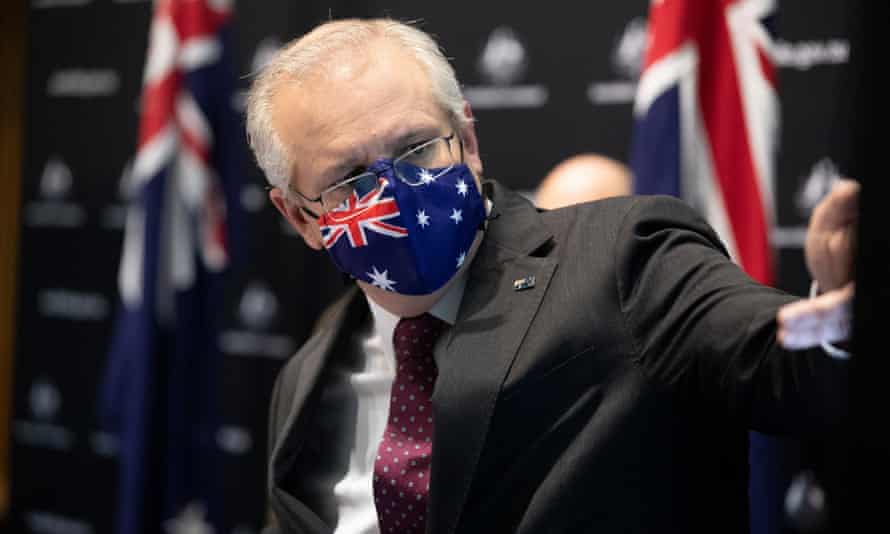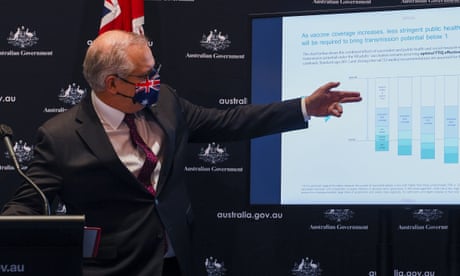The Doherty Institute modelling is important but the PM’s presentation was likely incomprehensible to anxious Australians watching at home

Last modified on Tue 3 Aug 2021 20.43 AEST
What a strange and unfulfilling day Tuesday was.
The government released modelling from the Doherty Institute. This is important, weighty material, and the public is anxious and aggravated. It would have been sensible to distribute it in advance, to convene an expert briefing, so journalists had some prospect of interrogating it in a methodical fashion. But the work was lobbed without preamble once the press conference was under way.
The press conference marking this occasion was broadcast live, and, sadly, the viewing experience was mostly incomprehensible. There was a political word salad, with a side serve of illegible powerpoint presentation – and I say that as a person who follows every beat of this pandemic. So let me try to distill some of the key information.
The Doherty modelling says until Australia achieves high vaccination coverage, any coronavirus outbreaks are likely to have “rapid and uncontrolled growth, with significant morbidity and mortality and requiring regular and extended lockdowns”.

Vaccinating half the adult population, or 60%, isn’t enough to suppress “rapid epidemic growth and high caseloads”. (Sorry Sydney. Hang in there.) Once we hit 70% or 80%, we will see “more substantial transmission reduction”.
Standing up to front these insights was Scott Morrison – the prime minister who pointedly praised Gladys Berejiklian five minutes ago for not rushing to lock Sydney down when it was obvious to most public health experts that the premier needed to act quickly.
Standing next to him was Josh Frydenberg – the treasurer who belted Daniel Andrews from here to next week when the premier locked down Victoria, a decision that spared the rest of the country from a major pre-Delta outbreak in the winter of 2020.
In summary, lockdowns used to be terrible: a lazy assertion of latent communism by premiers too incompetent to have efficient contact tracing. But lockdowns are OK now: necessary, even. Do keep up everyone.
It being a parliamentary sitting day, the press conference ebbed into question time. Unsurprisingly, Morrison’s very recent public commendation of Berejiklian for resisting going into a full lockdown got a mention from his opponents.
Asked to square his own circle on lockdowns, the prime minister proceeded to inform the chamber the Delta variant had been a great teacher, and he a humble pupil. “The Delta variant has completely changed the necessary responses,” Morrison said. “It has completely changed it.”
It is absolutely correct to say that the Delta variant is confounding public health experts and governments. We can all see this highly infectious strain is a lot more troublesome. As Doherty’s eminent expert Prof Jodie McVernon put it: “Having a more transmissible variant makes everything harder.”
But it didn’t take the arrival of the Delta variant to demonstrate that lockdowns can deliver effective suppression provided you don’t mess around, or amuse yourself by dabbling in some gratuitous partisan politics in the middle of a public health crisis.
We already knew that, because Victoria demonstrated that amply in 2020. It wasn’t that long ago. We were all here and could see it. With our own eyes. Even minus advanced epidemiological training.
So why did Australia (Morrison, incidentally, geolocated us all 28 times in under 10 minutes on Tuesday, perhaps understanding that constant whirling and pivoting is profoundly disorientating activity) need to be told that lockdowns are key to delivering effective suppression while we wait for higher vaccination rates, as if this is a stunning new insight?
Well, I suspect the answer lies in the fundamentals of what Doherty is telling us through their important work: Australia’s way out of this, from crisis to whatever Covid-normal looks like, is through high vaccination rates achieved across the population. Young people (reflecting the fact they are “peak transmitters” of the virus). Old people. The rest of us in the middle.
The new plan is a recalibrated version of the old plan, in other words. But there’s a hiccup with the crack on with the jabs insight. While the national rollout is certainly gathering pace now (turns out it was a race after all, one a society could demonstrably win or lose) – there are not yet enough vaccines in the country to deliver that endpoint right now, so we have to use the tools we have.
So the government now has to endorse the lockdowns it has spent much of the pandemic criticising, and explain this belated conversion to the bleeding obvious as a “learning” delivered by the Delta variant.
All pretty ordinary. Tuesday was strange and unfulfilling because the requirements of winning the daily politics again rode roughshod over substance. The raw political objective was a government attempting to spin itself out of a tight corner, to explain why the opposite was also true.
Perhaps the brutal simplicity of that objective explained why no one had bothered to check really basic things – like would the Doherty slides be legible to stressed-out people watching on television at home, hanging on every word?
It’s a pandemic, folks. This is not a rolling self-justification tribunal; it’s not a drill.
Emergencies confer clear objectives and responsibilities on political leaders. Inform the public. Put their needs first. Don’t be too clever by half. I don’t understand why this is so difficult for the government to grasp.
No comments:
Post a Comment